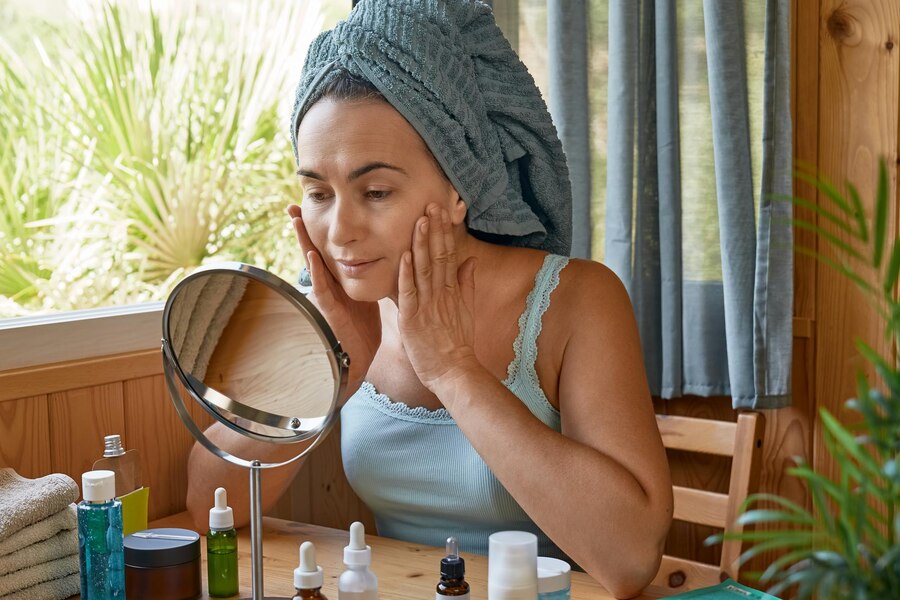What Are The Symptoms Of Skin Cancer?
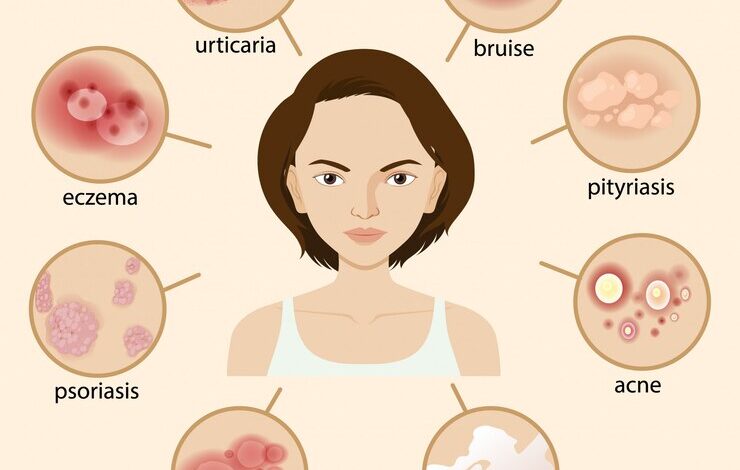
Skin cancer starts when skin cells grow out of control, usually due to sun exposure. It has three main types – basal cell carcinoma, squamous cell carcinoma, and melanoma. The beginning sign of melanoma is often a changing mole, like changes in size, shape, or color. Basal cell carcinoma might look like a pearly bump, a flat, skin-colored or brown lesion, or a sore that bleeds or scabs. While Squamous cell carcinoma could show as a firm, red bump or have a crusty, scaly top. Skin cancer is not limited to sun-exposed areas, urging the need to check all skin spots often. Spotting skin cancer early means it’s more likely to be treatable.
Key Takeaways
- Skin cancer is the abnormal growth of skin cells, often developed on sun-exposed skin.
- The three major types of skin cancer are basal cell carcinoma, squamous cell carcinoma, and melanoma.
- Melanoma often begins as a changing mole, while basal cell and squamous cell carcinomas have distinct visual characteristics.
- Skin cancer can develop in areas that are not typically exposed to the sun, so regular self-exams are crucial.
- Early detection of skin cancer significantly improves the chances of successful treatment.
Overview of Skin Cancer
Skin cancer is when skin cells grow abnormally. It’s a big health issue that comes in several types. The main ones are basal cell carcinoma, squamous cell carcinoma, and melanoma. They start in the epidermis, the skin’s top layer. Mutations in cell DNA make the cells divide too much, causing cancer.
Also Read : What Is Rosacea And Its Symptoms?
Types of Skin Cancer
Basal cell carcinoma is the most seen kind. It can look like a pearly bump, a scar-like spot, or a sore. Squamous cell carcinoma usually appears as a red bump or a crusty spot. Melanoma is the most dangerous. It might grow in a normal skin spot or a mole that changes shape, following the ABCDE rule.
Also Read : Discovering The Best PHD Scholarships For USA Students
Risk Factors and Causes
People with fair skin and a history of sunburns are at higher risk. So are those who spend a lot of time in the sun or live up high. Having many moles, a family history of skin cancer, or a weak immune system also increases risk. The main cause is UV damage from the sun or tanning beds.
Also Read : Exploring PHD Scholarship Opportunities In 2024
Importance of Early Detection
Finding skin cancer early is very important. It’s the best time for treatment success, preventing it from spreading. Regularly checking your skin and noticing any changes can help find cancers early. Seeing a dermatologist is key for checking any odd growths or changes.
Also Read : How To Applying For Merit Based MBA Scholarship Programs ?
Basal Cell Carcinoma Symptoms

Basal cell carcinoma is the top type of skin cancer. It stands out and often shows up on sun-kissed parts of your body. Being aware of its signs is crucial.
Also Read : Global MBA Scholarships For International Students
Appearance and Location
This cancer usually looks like a shiny bump. You’ll spot them more on your face, neck, and arms where the sun hits most. Sometimes they can seem flat, blending in with the skin, or look like a sore that keeps coming back.
Common Signs and Characteristics
These cancers are known to grow slowly. They might not spread but can mess with how you look if not managed. They often bleed, get scabby, or turn into sores that won’t heal, setting them apart from regular bumps or bruises.
Squamous Cell Carcinoma Symptoms
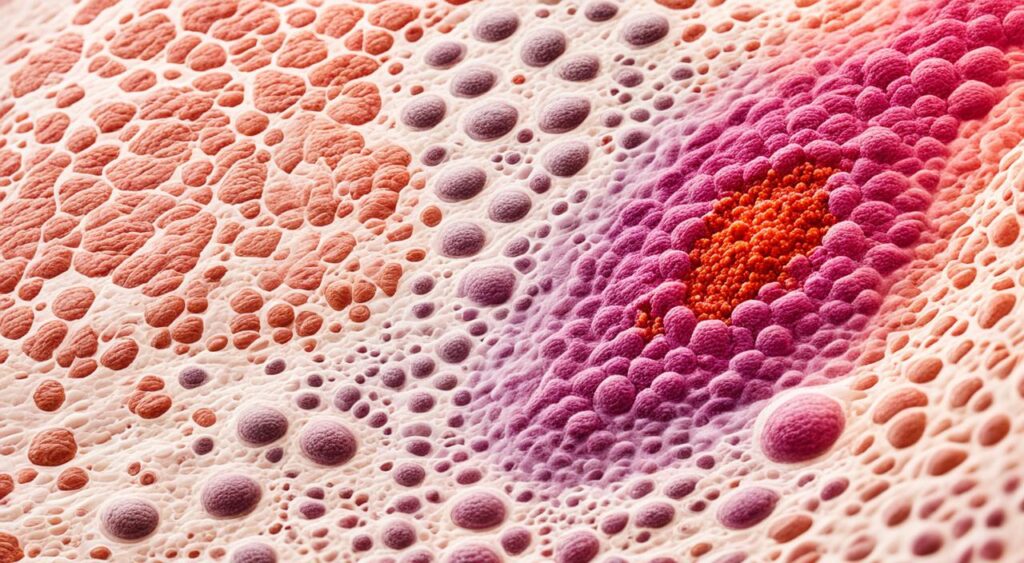
Squamous cell carcinoma is the second most common skin cancer. It often shows up on the face, ears, and hands. This type might look like a firm, red bump or a flat spot with a scaly top. People with darker skin tones might get it in unseen sun areas.
Areas Prone to Development
It mainly appears on the face, ears, and hands. These parts get lots of sun, which can lead to squamous cell carcinoma.
Visual Signs and Manifestations
It can look like many different things, from red bumps to scaly spots. Detecting it can be hard, so it’s key to have any iffy spots checked by a doctor.
Melanoma Signs and Symptoms
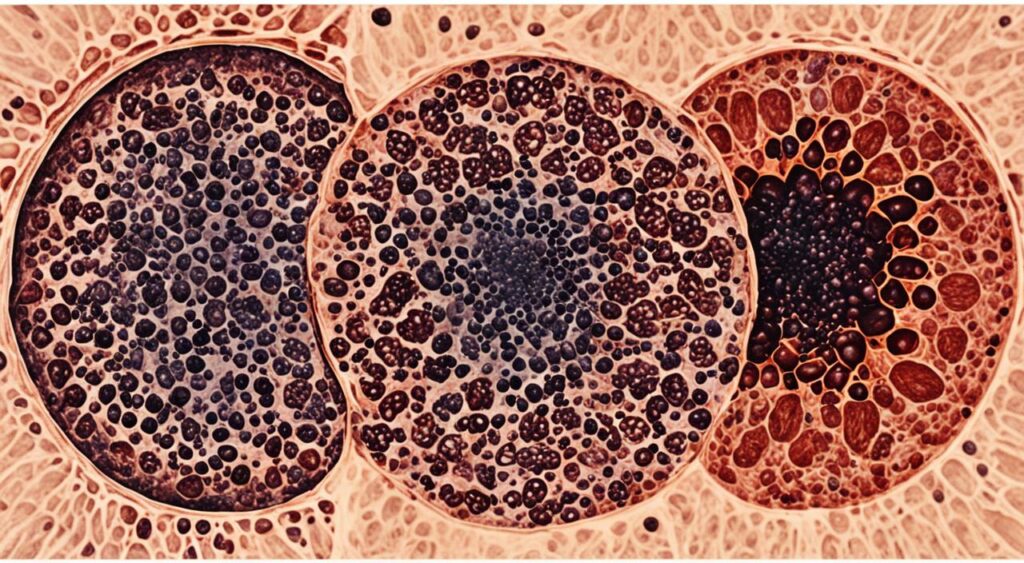
Melanoma is a severe form of skin cancer. It can start in normal skin or in a mole that turns cancerous. The first sign might be a changing mole.
The ABCDE Rule
The ABCDE rule guides us to spot melanomas: Asymmetry, Border irregularity, Color change, Diameter over 6 mm, and Evolving. These signs urge people to get odd moles or growths checked by a doctor.
Unusual Mole Changes
Besides the ABCDE rule, watch all moles for odd changes. Look for growth in size, odd borders, color changes, and new symptoms like itch or bleed. Melanoma can appear in places often not sun-exposed, like hands’ palms, feet soles, under nails, and on mucous areas.
Non-Skin Melanoma Symptoms
Melanoma can show up in the eyes, gut, or lymph nodes, not just skin. This could lead to eye changes, stomach pain, or unusual lumps. Seeing a dermatologist is key for any melanoma concern, wherever it appears.
Signs of Less Common Skin Cancers
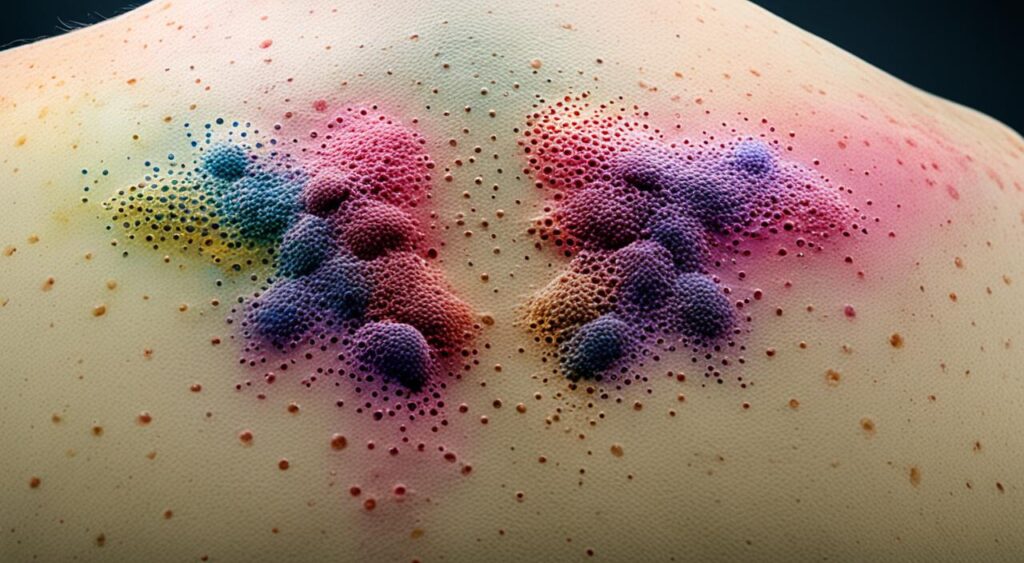
Basal cell carcinoma, squamous cell carcinoma, and melanoma are common skin cancers. But, other types exist, which are less common. They can be harder to find and may need special tests to diagnose.
Kaposi Sarcoma appears as red or purple patches on the skin or inside the mouth. It mainly occurs in people with a weakened immune system, like those with HIV/AIDS.
Merkel Cell Carcinoma looks like shiny, firm nodules usually seen on the head, neck, or trunk. This cancer type is fast-growing and difficult to detect and treat.
The third rare skin cancer is Sebaceous Gland Carcinoma. It starts in the oil glands and often looks like a painless nodule on the eyelid.
Although these cancers are not seen as often as others, knowing their signs is crucial. It’s important to spot any skin changes and tell a dermatologist right away.
Skin Cancer and Sun Exposure

The sun and tanning beds can cause skin cancer. They emit ultraviolet (UV) radiation. This radiation harms the DNA in our skin cells. As a result, cancer cells start to grow fast. This is a key reason why skin cancer develops.
UV Radiation and Skin Damage
The sun’s UV radiation is the top cause of skin cancer. It can go deep into our skin. There, it messes up our cells’ normal working. This causes them to change into cancerous cells. Such exposure, whether from the sun or tanning beds, raises our skin cancer risk a lot.
High-Risk Areas and Climates
Living in sunny, warm places or at high altitudes ups the skin cancer risk. This is because the sunlight is stronger there. The UV index, which gauges the sun’s ray strength, is often high in these spots. This means more risk of skin damage. People who’ve had severe sunburns, especially when young, also face a higher skin cancer risk.
Performing Regular Skin Self-Exams
Doing skin self-exams helps catch skin cancer early. Look at your skin carefully. Check for new or changing moles, sores that don’t heal, or anything odd. These could be signs of skin cancer.
What to Look For
Use the ABCDE rule when checking for melanomas:
- Asymmetry: One half of the mole might look different from the other half.
- Border irregularity: The edges can be ragged, rough, or not clear.
- Color variation: Moles might have many colors or shades, like brown, black, or red.
- Diameter: Look for moles larger than 6 millimeters, around the size of a pencil eraser.
- Evolving: Any mole that’s changing in size, shape, or color is a warning sign.
Seeking Medical Attention
If you see changes that worry you, get it checked out soon. Hoping off any problems can save your life. Seeing a skin doctor early for a check-in is key to beating skin cancer.
Skin Cancer in People of Color
Skin cancer doesn’t pick based on skin color. It can affect anyone, even those with darker skin. Often, people of color get skin cancer in places not touched by the sun much.
These spots include the palms, soles, under the nails, and inside the mouth. Because of this, it’s important for everyone to check their whole body for any changes.
Non-Sun-Exposed Areas
Skin cancer in darker skin tones can look different and be harder to spot early. This can make catching it early tough, leading to more advanced cases when it’s finally found.
Some reasons for this are unique genetic factors and a lack of awareness about skin cancer risks. These factors might drive up the number of late-stage diagnoses.
Unique Presentation and Risks
Finding skin cancer in people of color is a big challenge. This is because it doesn’t always look like what many expect. It often shows up in those hard-to-see areas. This means that by the time it’s found, it might be quite advanced.
In these cases, the late discovery can make treating the cancer harder. This can change how the disease progresses and how successful treatment is.
Diagnosis and Treatment Options
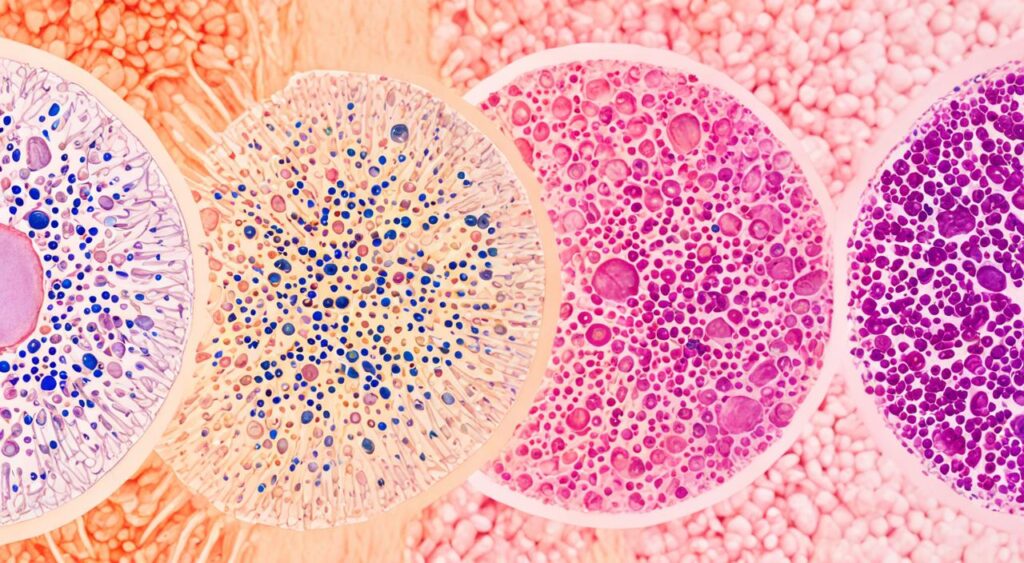
If a doctor finds a questionable skin growth, a biopsy is done to be sure. This might be taking a small piece or the whole growth to look at under a microscope. After finding out the kind of skin cancer, doctors will discuss how to treat it. Options include surgical removal, radiation therapy, and chemotherapy. There are also newer treatments like immunotherapy and targeted therapy. The type and stage of cancer, along with health and choices, will shape the treatment plan.
Biopsy and Diagnostic Methods
Getting a biopsy is key in figuring out if it’s skin cancer. A sample helps doctors know what type and stage of cancer it is. This decides the best way to treat it. Sometimes, other tests are used to see how much the cancer has spread.
Surgery, Radiation, and Chemotherapy
If the skin cancer is in the early stages, it’s often removed with surgery first. This can be done in different ways, like cutting it out, Mohs surgery, or freezing it. Radiation therapy or chemotherapy might also be used. These treatments can be given alone or with surgery. They help kill any cancer cells left.
Emerging Therapies and Clinical Trials
Experts are working on new ways to treat skin cancer. They’re looking into immunotherapy and targeted therapy. These new treatments help the immune system fight cancer or aim at its unique weaknesses. People might join clinical trials to try out these new treatments. Doing this can offer the latest ways to beat skin cancer.
Skin Cancer Prevention Tips
Finding ways to avoid UV radiation is crucial to prevent skin cancer. You should wear clothing like long sleeves, pants, and wide-brimmed hats. Using sunscreen with at least SPF 30 is a must.
Sun Protection Strategies
Choosing shady spots, especially around midday, is a smart way to lower UV exposure. Steer clear of tanning beds and sun lamps. Doing so will decrease your chances of skin cancer.
Lifestyle Factors and Risk Reduction
Eating right and exercising can boost your body’s defense against skin cancer. These lifestyle tweaks play a big part in preventing the disease. They also make you healthier and happier.
Also read: 10 Natural Remedies To Banish Pimple Scars
Conclusion
In summary, skin cancer is a serious health issue. But, with early detection and right treatment, it is manageable. It’s crucial to know the types of skin cancer, their signs, and symptoms.
The key is to do regular check-ups and seek professional advice. Also, prevention is vital. Wear sunscreen, protective clothes, and avoid tanning beds.
Seeing a dermatologist often and noting skin changes early are key. Luckily, there are better treatments now. So, being aware and taking steps to prevent it lowers the risk a lot.
In conclusion, taking skin cancer seriously is important. But, if we educate ourselves and act early, it can be controlled well. By caring for our skin and not ignoring any warning signs, we can stay ahead of the disease. This approach lessens its potentially severe effects on our lives.
FAQs
What are the symptoms of skin cancer?
Melanoma often starts as a mole that suddenly changes. It can grow in different sizes and shapes. Basal cell carcinoma shows up as a shiny bump or as a sore that won’t heal.
Squamous cell carcinoma might look like a growing red spot. Or, it can seem flat and scaly. Checking your skin often and telling your doctor about any new spots is really important.
What are the different types of skin cancer?
The main kinds of skin cancer are basal cell carcinoma, squamous cell carcinoma, and melanoma. They all begin in the skin’s outer layer, which is called the epidermis.
What are the risk factors and causes of skin cancer?
Light skin and too much sun can increase your risk. So can a lot of moles or a family history of skin cancer. The sun’s UV rays, and even tanning beds, can harm our DNA.
Why is early detection of skin cancer so important?
Finding skin cancer early means it’s easier to treat. Do skin checks often and tell your doctor about any changes right away.
What are the symptoms of basal cell carcinoma?
Basal cell carcinoma often looks like a shiny bump. It can also appear as a sore that comes and goes. This cancer usually shows up on the face, neck, and arms.
What are the symptoms of squamous cell carcinoma?
Squamous cell carcinoma can be a growing red lump. Or it can look flat and scaly. It most often appears on the face, ears, and hands.
What are the signs and symptoms of melanoma?
Melanoma might start as a mole that changes. You can spot a potential melanoma by its look: Asymmetrical, Bad borders, Changing color, Big size, and Different over time.
It’s not always on sunny parts of the body. So, check everywhere, even under nails or on the feet.
What are some less common types of skin cancer?
Other skin cancers like Kaposi sarcoma and Merkel cell carcinoma are rare. They are harder to find and may need special tests.
How does sun exposure and UV radiation contribute to skin cancer?
UV radiation from the sun is the main cause. It changes the DNA in our skin cells, leading to cancer. Living in sunny places or at high altitudes makes the risk higher.
How can I perform regular skin self-exams?
Look for any new or changing moles, sores, or growths. Use the ABCDE rule to check moles: Asymmetry, Bad borders, Changing color, Big size, Evolving. If you see a worrying change, visit a dermatologist.
Are people of color at risk for skin cancer?
Yes, people of all skin tones can get skin cancer. Even if you’re not often in the sun, you can develop it. Often, it’s in hidden places. It’s harder to see on darker skin, making it tough to detect early.
How is skin cancer diagnosed and treated?
A suspicious spot is usually checked with a biopsy. Treatment options vary but can include surgery or newer treatments like immunotherapy. The action taken depends on the cancer type, its stage, and your health.
How can I prevent skin cancer?
Avoid too much sun and tanning beds. Wear protective clothing and regularly use sunscreen. Stay fit and visit your dermatologist for check-ups. Early detection and prevention are key.





